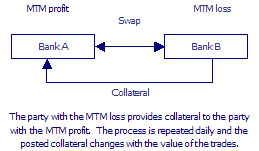
Barbican Consulting Limited
Collateral Management

Credit Exposures
Banks have long recognised that over-the-counter, (OTC), derivatives like swaps and options can create counterparty credit exposures. That is why these products require internal credit approval. What causes the credit risk?
Suppose two parties enter into a swap. As interest rates change one party will have a mark-to-market, (MTM), profit on the deal. The other party will have a loss.
If the party losing money defaulted the party that was "in-the-money" would have to replace the deal at current market prices. The profit would be lost. The positive MTM value is a credit exposure.

This risk may not be large for short dated deals. But for long dated deals it increases. And there is no guarantee that your counterparty will maintain a prime credit rating in the future. This is why banks often record the credit risk on a swap as the MTM value plus an add-on for the potential future credit exposure.
One way to reduce the credit risk is to use a break clause. Bilateral break clauses permit either party to break the swap on agreed future dates. If the swap is broken the MTM value is exchanged and both parties are free to replace the deal elsewhere. But you can improve on break clauses and reduce credit risk even further. This is what collateral management is about.
What is collateral management?
Collateral management is a process. It helps to reduce counterparty credit exposures. It is normally used with over-the-counter derivatives like swaps and options. If two parties agree to enter into collaterisation this is what happens.
The two parties negotiate and execute a collateral support document, (CSD), this contains the terms and conditions under which collateralisation will take place.
The trades subject to collateral are regularly marked-to-market. Their net valuation is then agreed.
The party with the negative MTM on the trade portfolio delivers collateral to the party with the positive MTM.
As prices move and new deals are added the valuation of the trade portfolio will change.
Depending on what is agreed the valuation is repeated at frequent intervals-typically daily, weekly or monthly.
The collateral position is then adjusted to reflect the new valuation. The process continues unless one of the parties defaults.
In simple terms the collateral process is very similar to futures variation margining. The party that has a MTM loss must post collateral, (see the diagram below).

What happens if there is default?
Suppose your counterparty defaulted and from your perspective the trade portfolio is "in-the-money", normally you would have an unsecured credit exposure. But with collateral, provided you serve the appropriate legal notices, you can terminate the trades and use the collateral as repayment. Provided the collateral value is sufficient your MTM profit is protected. Your credit risk has been mitigated.
This all sounds simple. But there is more to collateral than meets the eye. Let's look at some of the issues.
Will you encounter collateral management?
This market is growing. According to ISDA there were over 70,000 collateral agreements in place covering USD1.017 trillion of collateral in 2005. As derivative markets have grown today's figure will be higher. If you use OTC derivatives it is likely you have collateral agreements in place. If not it is probable that you will be asked. Agreeing collateral documentation is a process of negotiation you do not have to accept all the terms requested and you can impose some of your own.
Why the growth?
Collateral management has benefits. It can reduce potential credit losses and capital usage, it can increase the number of transactions you do with a party and may also reduce dealing spreads.
What trades are subject to collateral?
Normally OTC derivatives are subject to collateral. Careful consideration should be given to the trades included. If you cannot accurately value the trade you will be reliant on the valuation made by the counterparty. This is why some parties restrict collateral to swaps and exclude complex trades.
What is used as collateral?
The most popular form of collateral is cash. In 2005 ISDA indicated that USD and EUR cash accounted for 73% of collateral assets.
Why is cash so popular? Because cash has big advantages, it is easy to value, transfer and hold.
When you give cash collateral you receive interest. When you take cash collateral you pay interest. In the documentation it is normal to mutually agree the use of an overnight index rate like EONIA.
You can also use other forms of collateral like bonds. Depending on their credit rating and liquidity they may be subject to a valuation percentage or haircut.
Is it straight forward?
You can think of collateral management as a process that exchanges credit risk for operational risk. If you are considering implementing collateral management you may wish to consider the following points:
You still need to assess the creditworthiness of your counterparty.
The reasons why you are using collateral should be documented.
The legal agreements used must be suitable and enforceable.
The regular process of collateral calls and returns will need to be carried out by a responsible individual or team.
Timely and accurate valuation data needs to be used.
They will need to know what type of collateral is applicable, the valuation percentages, independent amounts, thresholds, minimum transfer amounts, rounding amounts and currencies that apply.
They will also need to know what collateral is currently in transit and what events are pending each day.
The reduction in credit risk as a result of collateralisation needs to be captured by credit management systems.
Failure by the counterparty to deliver collateral will need to be swiftly followed up.
There needs to be the appropriate escalation processes for disputes and defaults.
This is why you need to carefully consider the operational risks and costs and compare them with the benefits you hope to achieve before you sign a credit support document.
Do disputes happen?
Yes, trade valuations between parties will always differ. But is the difference significant? It is important to have an escalation process that handles disputes so they are investigated and resolved satisfactorily. To reduce the possibility of disputes practitioners suggest that trade reconciliation is done before collateralisation is commenced.
Disputes can be caused by variations in the data used for valuation. Yield curves captured at different times and from different sources may be the source of the problem.
Sometimes disputes are serious and need to be resolved. For example, the parties may have different trade data or even missing trades. Problems of this nature require the parties to reconcile their portfolios.
Can collateral management make money?
The short answer is "no". But when properly managed it reduces credit risk. Trade portfolios between counterparties can have MTM values running into tens of millions of dollars. These exposures can become so large that they prevent further trades being done. It is therefore not surprising that traders can become advocates of using collateral management to facilitate further dealing with counterparties.
Glossary
Some of the terms used are explained in more detail below:
Call & return amounts: The collateral amount that is being requested or given back.
Credit support document (CSD): CSDs are the documents that are agreed between the two parties that are establishing a collateral relationship. Normally the trades are documented under an ISDA Master Agreement, the CSDs then take the form of an annex or supplement to the Master Agreement.
Independent Amounts: The independent amount is an additional credit support amount that is required over and above the market value of the trade portfolio. The main purpose of the independent amount is to cater for changes in the market value of the trades between collateral calls. The independent amount can be a fixed amount or a percentage of the nominal size of the portfolio. There is resistance to providing an independent amount because it can adversely affect a firm's liquidity.
Mark-to-market (MTM): The current market value of a trade or trade portfolio.
Minimum transfer amount (MTAs): Collateral calls for amounts smaller than the MTA are not permitted. MTAs are designed to prevent the calling of nuisance amounts. This avoids unnecessary costs involved in small transfers. Typically the MTA will lie in the range of $50,000-$1,000,000. Increasingly there is a trend to set the independent amount at zero and use the MTA as a type of threshold.
Netting: Netting permits individual trade values to be added together to provide a single exposure. This is important to collateral management. If netting cannot be enforced you may end up with a gross exposure to the counterparty and insufficient collateral to cover it.
Threshold amounts: The threshold amount is an unsecured credit exposure that the parties are prepared to accept before asking for collateral. Ideally threshold amounts are set at relatively low levels in order to maximise credit risk mitigation.
Trade portfolio: The trades that are subject to the collateral process.
Valuation percentage: This is also called a "haircut". It is a percentage by which the market value of the collateral will be reduced. For example, collateral with a market value of $10m and a valuation percentage of 98% is only recognised as $9.8m for collateral purposes. Valuation percentages protect the collateral taker against falls in the value of the collateral during the period between collateral calls.
First published by Barbican Consulting 2006